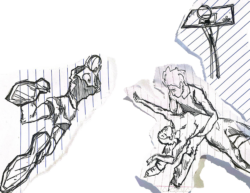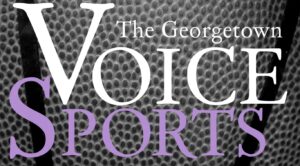To many familiar with the men’s basketball team’s woeful season, the reasons behind the collapse are not obvious. At times the team has played as well as anyone in the country, making huge runs against quality teams like No. 7 Duke, No. 8 Pittsburgh and No. 10 Notre Dame; other times the team has looked utterly confused, blowing late leads against mediocre St. John’s and Rutgers.
“I don’t know what to tell you,” said Head Coach Craig Esherick in yesterday’s Washington Post after the Hoyas’ 66-59 defeat at the hands of Rutgers. “I really don’t know what it is.”
The best way to understand “what it is” would be to compare the first place team in the Big East West Division, Notre Dame (19-4 overall, 7-2 Big East), to the last place team, Georgetown (10-10 overall, 2-7 Big East). To equalize the competition, the comparison is limited to statistics from both teams’ games in the Big East and four primary non-conference opponents, 13 games in total.
With surprisingly minor statistical differences separating the two teams, it becomes clear that mental errors and the inability to execute in the clutch are what is holding the Hoyas back.
Shooting—One of the most frequent criticisms of the Hoyas is that they do not have reliable shooting. Georgetown’s main outside threats are junior swingman Gerald Riley, sophomore guard Tony Bethel and first-year forward Brandon Bowman. In 13 games, the three combined shot 37.6 percent from the floor. Notre Dame’s primary shooters, sophomore guard Chris Thomas, senior guard Matt Carroll and senior forward Dan Miller, shot only two percentage points higher at 39.4 percent. The percentage is further equalized because Thomas, Carroll and Miller are the Irish’s leading players, while the Hoyas’ best scorer is indisputably junior forward Mike Sweetney, who is not an outside shooter. Shooting is not the Hoyas’ problem.
Defense—The Hoyas have been criticized for defensive lapses, especially while covering opposing teams’ guards, but Georgetown’s defensive statistics compare well with Notre Dame’s. The Hoyas have allowed 76.8 points per game compared to the Irish’s 75.0. Additionally, Georgetown leads Notre Dame in blocks and steals per game with the Hoyas averaging 2.3 more blocks and 2.0 more steals. Even against opposing guards, Georgetown does not compare unfavorably. Leading guard scorers are averaging 17.4 points against the Hoyas, while leading guard scorers are averaging 15.4 points against the Irish. Defense does not appear to be Georgetown’s primary deficiency.
Intangibles-Rebounding, foul shooting and turnovers are statistics often mentioned as reflecting the mental toughness of a team. In these areas, Georgetown does not measure up to Notre Dame. While the rebounding totals are even-the Hoyas’ rebounding margin is 0.97 of their opponents’ and the Irish’s is 0.98-Notre Dame dominates in the other statistics. The Irish are shooting 78.6 percent from the foul line, while the Hoyas are shooting 70.8 percent-incomparable, as Georgetown does not have a similar outstanding statistic that could counter the Irish’s free throw percentage. The most telling statistic is turnover margin. Notre Dame’s turnover margin is 0.95 of its opponents, while Georgetown’s is 1.11. This number is exacerbated by Georgetown’s larger number of steals, meaning that the Hoyas are making many more mental errors than their opponents, including Notre Dame.
Close Calls—The most persistent criticism of the Hoyas is their inability to close out close games. Georgetown’s record this year in its 12 games decided by 10 points or less is an underwhelming 3-9. The most logical decision in these situations is to put the ball in the hands of the team’s best player, Sweetney. Five times Georgetown has had the chance to tie or win at the end of a game but all five times Sweetney has not touched the ball: Georgetown’s record in these games is 1-3. Notre Dame’s record in its nine games decided by 10 points or less is 7-2. The Irish have had three chances to tie or win a game in the final possession and their best player, Thomas, has been involved all three times. Notre Dame’s record in these three games is 3-0.
While it is true that since Thomas is a point guard he has a better chance of controlling the ball than power forward Sweetney, not once has Georgetown gotten the ball inside to its best player when the game has been on the line. Simply put, the Hoyas never give Sweetney a chance to win the game for them.
Over the past two seasons, the Hoyas’ effort cannot be questioned; the team is never blown out and never gives up when down in the second half. Still, Georgetown has lost 21 games in the past two seasons by a total of 132 points, an average of 6.3 points per game. These games are too hard-fought for the players, coaches, administration and fans not to be frustrated. The disappointment is multiplied by controversial incidents involving the Hoyas: the decision not to participate in last year’s National Invitation Tournament, Esherick’s tirade against the referees after this year’s West Virginia game, Director of Athletics Joe Lang’s comments in the Washington Post, six Seton Hall players on the court at the end of a loss and rumors surrounding senior center Wesley Wilson’s absence from the team.
If the Hoyas can correct their late-game problems, the players’ desire and effort is there.
“I don’t think this team deserves this,” said Hall after the Notre Dame loss. “We’ve worked so hard.”




